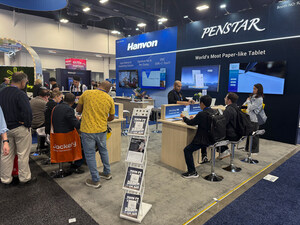Hanvon Shows Leadership in Three Leading Technologies at Mobile World Congress 2013
BARCELONA, Feb. 27, 2013 /PRNewswire/ -- Following last month's CES, Mobile World Congress (MWC) 2013 – another key annual event in the mobile communication industry – is taking place in Barcelona, Spain. As the technology leader in the pattern recognition field, Hanvon let show participants in Barcelona experience the future with its electromagnetic module, handwriting and OCR (Optical Character Recognition) technologies.
When Apple rolled out the first iPhone, their capacitive touch technology dominated attention in the field. However, at last year's MWC, leading global mobile phone makers, led by Samsung, launched dedicated electromagnetic pen products, reconnecting the public with the irreplaceable role electromagnetic module technology plays in the human-computer interaction field.
The latest chips developed by Hanvon, the only company that owns wireless passive electromagnetic module technology in China, have, over the last half year, become the undisputed world leader, with technology featuring lower energy consumption and higher precision.
In the onsite PAD demonstration sector, Hanvon has evidenced that electromagnetic module technology can faithfully reproduce a person's handwriting. The technology is designed to be responsive to up to 2,048 levels of pen pressure sensitivity. Even when users use the slenderest of pens to touch the screen, the technology is capable of clearly capturing and displaying every stroke. Compared to the current mainstream capacitive and resistive touch screen technologies, the electromagnetic module technology not only faithfully reproduces the user's original handwriting, but also with a substantially higher level of precision. In addition, the technology's synchronization between input and display exceeds those available in existing touch technologies. Besides mobile phones and tablet PCs, the technology is also widely used in paint applications, electronic white boards, e-books and e-signature devices, among others, becoming the core technology to drive the no-paper office environment in future society.
In the current era of the mobile internet, with more and more smartphones evolving into intelligent terminals, industry analysts believe that demand will continue to rise for input methods and especially smart options. Users with different entry habits will require smart association and the ability to recognize and act on the input of short amounts of text.
Hanvon's touch input technology is widely recognized for its "multi-platform, multi-language and multi-application" capabilities and is used by nearly 90 percent of the vendors worldwide, including Samsung, Lenovo, ZTE, Huawei and Haier. Hanvon now has over 100 million touch input users. During MWC 2012, the company released its Hanvon IME for tablet, which is acclaimed for its sentence-level capabilities. At this year's MWC, Hanvon debuted its "Magic Square" input application, which not only eliminates the necessity to switch between Chinese, English, numbers and punctuation, but also provides support for cursive character recognition and phrase-level input in more than 40 languages. A truly novel feature is the capability of being able to output the "look and feel" of a user's handwritten text as if the user had written the words using a pen, pencil or even a calligraphy brush, through an optimized interpretation of the user's motions when handling the stylus.
On the other hand, with the development of intelligent in-car navigation systems, more and more automakers have started incorporating superior handwriting navigation systems into their new car models. Mercedes-Benz, Toyota and other makers have deployed Hanvon's pen input technology in a select number of their car navigation systems, greatly improving the handwriting input capabilities of factory-installed navigators and giving rise to a new wave of handwriting car navigation solutions.
In addition to electromagnetic modules and pen input solutions, Hanvon's OCR technology also drew the attention of many visitors at the event. The Business Card Reorganization System proved impressive for its strong identification and intelligent input capabilities. Using a mobile-phone camera to scan the English-language version of the exhibition handbook, the technology translated the text into Chinese instantly. Hanvon's OCR solutions have spread beyond the early industry-based applications and into the mass consumer electronics sector. At the event, Hanvon brought to the fore an entire new level of user experience that could usher in a new touch control technology revolution.
SOURCE Hanvon
WANT YOUR COMPANY'S NEWS FEATURED ON PRNEWSWIRE.COM?
Newsrooms &
Influencers
Digital Media
Outlets
Journalists
Opted In






Share this article